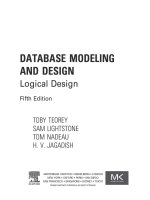Database security and recovery
Bạn đang xem bản rút gọn của tài liệu. Xem và tải ngay bản đầy đủ của tài liệu tại đây (231.13 KB, 44 trang )
Chapter 07: Database Security and
Recovery
Database Security
Introduction
•
Database security issues are often lumped together
with data integrity issues, but the two concepts are
really quite distinct. Security refers to the
protection of data against unauthorized disclosure,
alteration, or destruction; integrity refers to the
accuracy or validity of that data.
•
To put it a little glibly:
–
Security means protecting the data against unauthorized
users.
–
Integrity means protecting the data against authorized
users.
Need for Database Securit
•
In the case of shared data, multiple users try to
access the data at the same time. In order to
maintain the consistency of the data in the
database, database security is needed.
•
Due to the advancement of internet, data are
accessed through World Wide Web, to protect the
data against hackers, database security is needed.
•
The plastic money (Credit card) is more popular.
The money transaction has to be safe. More
specialized software both to enter the system
illegally to extract data and to analyze the
information obtained is available.
General Considerations
•
There are numerous aspects to the security
problem, some of them are:
– Legal, social, and ethical aspects
– Physical controls
– Policy questions
– Operational problems
– Hardware control
– Operating system support
– Issues that are the specific concern of the
database system itself
Database Security System
Database Security Goals and Threats
•
Security threat can be broadly classified into
accidental, intentional according to the way they
occur.
•
The accidental threats include human errors, errors
in software, and natural or accidental disasters:
– Human errors include giving incorrect input, incorrect
use of applications.
– Errors in software include incorrect application of
security policies, denial of access to authorized users.
– Natural or accidental disasters include the damage of
hardware or software.
Classification of Database Security
•
Physical security.
–
Physical security refers to the security of the
hardware associated with the system and the
protection of the site where the computer
resides. Natural events such as fire, floods, and
earthquakes can be considered as some of the
physical threats.
•
Logical security.
–
Logical security refers to the security measures
residing in the operating system or the DBMS
designed to handle threats to the data.
The DBMS’s security mechanism
•
security rules:
–
made known to the system
•
appropriate definitional language
–
remembered by the system
•
security / authorisation rules stored in the catalogue
–
checked by the system
•
security / authorisation subsystem
Discretionary access control
•
example in a pseudo-code
CREATE SECURITY RULE Rule1
GRANT RETRIEVE ( S_id, S_name, City ) , DELETE
ON Suppliers WHERE City ≠ ‘London’
TO Jim, Fred, Mary
ON ATTEMPTED VIOLATION Reject ;
Discretionary access control
•
components of a security rule
–
name (Rule1) (why?)
–
privileges (RETRIEVE on certain attributes, )
–
scope (ON … WHERE …)
–
users (user IDs)
–
violation response (procedure)
General format of a rule (pseudo-code)
CREATE SECURITY RULE <name>
GRANT <list of privileges>
ON <expression>
TO <list of userIDs>
[ ON ATTEMPTED VIOLATION <action> ] ;
Clarifications
•
possible privileges are:
•
RETRIEVE [ ( <attribute-list> ) ]
•
INSERT
•
UPDATE [ ( <attribute-list> ) ]
•
DELETE
•
ALL
•
data definition operations
•
Clarifications
•
<expression>
•
is an expression of relational algebra
•
target: (one range variable which should refer to) only one
relation; i.e. the scope of the rule is a subset of of the tuples of
a single relation
–
this restriction is somehow ad-hoc; though, it induces in simplicity
•
<action>
•
default: reject
•
but it could be on any complexity, in theory
–
examples - what would it be needed?
SQL’s GRANT and REVOKE
GRANT <list of privileges>
ON <data object>
TO <list of userIDs> | PUBLIC
[ WITH GRANT OPTION ]
REVOKE [ GRANT OPTION FOR] <list of privileges>
ON <data object>
FROM <list of userIDs> <option>
Clarifications
•
privileges
•
USAGE (for domains), SELECT, INSERT (column specific),
UPDATE (column specific), DELETE, REFERENCES (for
integrity constraint definitions)
•
<data object>
•
DOMAIN <domain>
•
[ TABLE ] <table> (a base table or a view)
•
<option>
•
RESTRICT | CASCADE
Example #1
CREATE VIEW View1 AS
SELECT S_id, S_name, Status, City
FROM Suppliers WHERE City = ‘Paris’
GRANT SELECT, INSERT,
UPDATE ( S_name, Status ), DELETE
ON View1
TO Mark, Spencer
Example #2
CREATE VIEW View2 AS
SELECT S_id, S_name, Status, City FROM S WHERE
EXISTS
( SELECT * FROM SP
WHERE EXISTS
(SELECT * FROM P
WHERE S.S_id = SP.S_id AND
P.P_id = SP.P_id AND P.City = ‘Rome’ )) ;
GRANT SELECT ON View2 TO John
CREATE VIEW View3 AS
SELECT P_id, ( SELECT SUM (Contracts.Qty)
FROM Contracts
WHERE Contracts.P_id = Parts.P_id )
AS Quantity
FROM Parts;
GRANT SELECT ON View3 TO Bill
Example #3
GRANT INSERT
ON Transactions
WHERE Day() NOT IN (‘Saturday’, ‘Sunday’) AND
Time() > ’ 9:00’ AND Time() < ‘17:00’
TO Till; Till is a group of users
Example #4
Other issues
•
logical “OR” between security rules
•
anything not explicitly allowed is implicitly
prohibited
•
audit trial - for critical data
•
request (text), terminal, user, date and time, data objects
affected, old values, new values
Mandatory access control
•
each data object has a classification level
•
each user has a clearance level
•
rules
•
user U can see object O if the clearance level of U is greater
or equal to the classification level of O
•
user U can modify object O only if the clearance level of U is
equal to the classification level of O
•
used for DBs with a static and rigid classification
structure
Data encryption - generalities
•
when the system was bypassed
•
plain-text
•
original data
•
encryption
•
encryption algorithm, encryption key
•
cipher-text
•
encrypted text
An encryption algorithm
•
divide text into blocks of length equal to the encryption
key
•
replace each character by a corresponding integer
(blank=00, a=01, …, z=26)
•
repeat for the encryption key
•
for each block, sum modulo 27 the corresponding integers
with those of the encryption key
•
replace each integer with the corresponding character
Database Recovery









